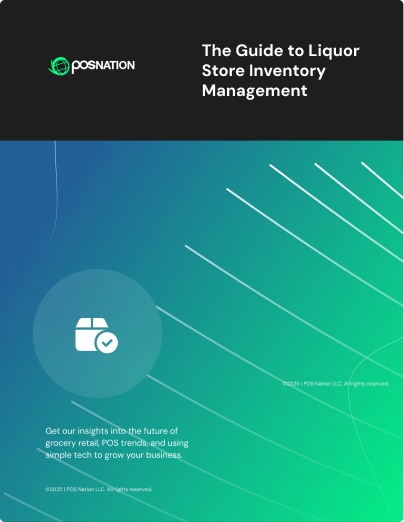As a retail store owner, you process dozens of point of sale (POS) transactions every day. But have you stopped to consider what a point of sale transaction really is? If you want to maximize your efficiency, you need to understand more than just the basics of ringing items up.
So, what is a point of sale transaction? How do the mechanics of these exchanges work? And what are the best practices you should follow to get the most from your sales processes and tools?
In this guide, we’ll provide a full guide to POS transactions, from the hardware and software that powers them to the processing methods that move money from your customer's account to yours. We'll explore how different industries handle unique transaction types and provide practical tips for selecting the right POS system for your specific business needs.
Answered: What Is a Point of Sale Transaction?
Before we get into the nitty-gritty details, let’s answer the central question of this post: What is a point of sale transaction?
At its most basic level, a POS transaction is the moment a customer makes a payment for a product or service at your business. It used to be a simple exchange of cash for goods, but modern point of sale transactions are a little more involved, capturing customer data and updating inventory counts in real time.
Related Read: 5 Tips for Using Retail Analytics To Boost Your Profits
Mastering POS transactions is critical to running an efficient retail business. When transactions flow smoothly, you'll process more sales per hour, collect data that helps you make better business decisions, and create the kind of checkout experience that keeps customers coming back. But clunky, outdated systems slow you down and drive your customers away.
Let's dive into everything you need to know about POS transactions to set your business up for success.
The Anatomy of a Point of Sale Transaction
Every time a customer makes a purchase, they kick off a complex exchange of funds and information. Understanding the components of this process is important if you want to troubleshoot challenges quickly. Let’s explore the breakdown of the tools and parties involved in any point of sale transaction.
A complete POS transaction involves multiple players working together to verify, authorize, and complete the sale. Here's who participates in this process and what role each plays:
- Customer: The person purchasing your products or services who provides payment and receives goods
- Merchant (you): The business selling products or services that initiates the transaction through your POS system
- Payment method: The form of payment used (credit card, cash, mobile payment, gift card, etc.)
- Point of sale system: Your hardware and software that captures transaction details, updates inventory, and sends payment information for processing
- Payment gateway: The technology that encrypts and securely transfers payment data from your POS to the payment processor
- Payment processor: The service that routes transaction information between banks and verifies that funds are available
- Acquiring bank: Your merchant bank that receives funds from the customer's bank and deposits them into your account
- Card network: Companies like Visa, Mastercard, or American Express that facilitate communications between processing networks
- Issuing bank: The financial institution that issued the customer's credit or debit card and authorizes the transaction
The entire transaction typically takes seconds to complete, but it involves multiple security checks, authorization protocols, and data transfers simultaneously.
A well-designed POS system streamlines this entire process, making it nearly invisible to you and your customers while gathering valuable customer and sales data you can use to grow your business.
The Step-by-Step Payment Processing Journey
With an understanding of the components of a point of sale transaction in mind, let’s take a look at how the whole process comes together in seven steps.
Step 1: Transaction Initiation
The journey begins when your customer presents their preferred payment method at checkout. This might be a physical credit card inserted into your card reader, a tap of a smartphone for mobile payments, cash handed to your cashier, or an online payment through your e-commerce site.
Your POS system captures the essential transaction details, including items purchased, quantities, prices, taxes, and discounts, and prepares this information along with the payment amount for processing.
Step 2: Authorization Request
Once your customer presents their payment method, your POS system packages the transaction data and sends it through a payment gateway. Think of the payment gateway as a secure tunnel that encrypts sensitive payment information to protect it while it’s in transit.
The gateway reformats this data according to security protocols and routes it to the appropriate payment processor based on the card type. This entire step typically takes just fractions of a second, but includes multiple security measures to protect both you and your customer.
Related Read: What Is POS Cybersecurity? 6 Tips for Securing POS Data
Step 3: Payment Verification
After receiving the encrypted transaction data, the payment processor routes the authorization request to the customer's issuing bank (for card payments) or relevant financial institution.
The bank then verifies several critical factors:
- Whether the account exists
- If the card hasn't been reported stolen
- If sufficient funds or credit are available
- Whether the transaction triggers any fraud alerts
For cash transactions, verification happens at the register when your cashier counts the money.
Step 4: Transaction Approval (or Decline)
Based on the verification results, the issuing bank sends an approval or decline message back to your point of sale system through the same network. If the payment is approved, an authorization code is generated. If it’s declined, you’ll see a reason code (such as insufficient funds or suspected fraud).
This response travels back through the card network, to the payment processor, through your payment gateway, and finally to your POS system. Your system then displays the result to both you and the customer.
Step 5: Sale Completion
If the transaction is approved, your POS system finalizes the sale by generating a receipt, updating inventory records, and recording customer information if applicable. The customer receives their products or services and a receipt (printed, emailed, or texted). Behind the scenes, the authorization places a hold on the customer's funds, but the money hasn't actually moved to your account yet — that happens during settlement.
Step 6: Settlement
Settlement is when you actually get paid. At the end of your business day (or sometimes multiple times daily), your payment processor initiates a settlement request to transfer the authorized funds from customers' accounts to your merchant account. It typically takes 24–48 hours for the funds to become available in your account.
Step 7: Reconciliation and Reporting
The final step happens when your POS system generates reports that help you reconcile the day's transactions. These reports detail all approved sales, declined transactions, returns, discounts applied, taxes collected, and payment methods used.
Modern POS solutions automatically match these transactions against your bank deposits, flagging any discrepancies that need attention. This data also feeds into your accounting software, giving you key insights for inventory management and marketing decisions.
Types of Point of Sale Transactions
We’ve briefly covered the different types of payment methods — now, let’s dig a little deeper. In your retail business, you might encounter four main categories of point of sale transactions: cash transactions, card-present transactions, card-not-present transactions, and mobile/contactless payments.
Let’s explore each of these in detail:
- Cash transactions: Though cash is becoming less and less popular every year, it’s still a relevant payment method that many of your customers want to use. For small-ticket items under $5–10, cash can be more cost-effective than card payments that incur minimum fees. However, cash requires secure handling procedures and regular reconciliation, and exposes your business to theft risks and counterfeit currency. Best practices include using cash drawers that open only during transactions, performing regular counts, and implementing dual-control procedures for large amounts.
- Card-present transactions: When customers physically present credit or debit cards at your location, it’s called a card-present transaction. This payment method offers a lower processing fee than online transactions. Modern EMV chip readers add security by creating unique codes for each transaction, dramatically reducing fraud. Your POS system should support chip insertion, magnetic stripe swiping (as backup), and PIN verification for debit transactions.
- Card-not-present transactions: In this type of transaction, as the name suggests, a customer complete a purchase without presenting the physical credit card they’re using to pay. Online sales, phone orders, and manually keyed transactions fall into this category. These transactions have higher processing fees due to increased fraud risk. Without physical verification, these transactions require additional security measures like address verification (AVS) and CVV code validation.
- Mobile and contactless transactions: The fastest-growing payment category includes tap-to-pay cards and digital wallets like Apple Pay, Google Pay, and Samsung Pay. These transactions use near field communication (NFC) technology to securely transmit encrypted payment data. They’re faster than chip-authorized payments and offer better security through tokenization. To accept these payments, ensure your POS hardware includes NFC readers and that your payment processor supports these transaction types.
Related Read: The Importance of Mobile Pay and Contactless Payments
Though these four categories represent the vast majority of point of sale transactions, your store may offer alternative payment methods like buy now, pay later services (including Affirm and Klarna) or cryptocurrency. If you intend to accept these payment methods, be sure to review the processing fees and currency conversion costs.
How To Maintain POS Transaction Security
Point of sale security is critical to protecting your bottom line from losses due to theft, penalties, or manual errors. Poor POS security can also damage your store’s reputation and cost you customers. Let’s examine some of the security measures you should take for your store:
- PCC DSS compliance: The Payment Card Industry Data Security Standard (PCI DSS) establishes requirements for businesses that handle cardholder data. Your POS system should offer built-in compliance features, but you're still responsible for secure implementation. Requirements include maintaining a secure network, protecting cardholder data, maintaining a vulnerability management program, implementing access controls, regularly monitoring and testing networks, and maintaining an information security policy.
- Encryption and tokenization: Encryption converts sensitive data into unreadable code that requires a decryption key to access. Tokenization replaces actual card data with meaningless symbols that can't be reverse-engineered, making them useless if stolen. Modern POS systems should implement end-to-end encryption that protects data from the moment a card is swiped or tapped until it reaches the payment processor, never storing actual card numbers on your local system.
- EMV chip technology: The chip in modern payment cards creates a unique transaction code for each purchase, making it virtually impossible to create counterfeit cards from stolen data. Since the liability shift in 2015, merchants without EMV readers may be financially responsible for certain types of fraud. Ensure your POS hardware supports EMV technology, and train staff to encourage chip insertion (or tap-to-pay) rather than fall back to magnetic stripes, which lack the same protections.
When maintaining a secure point of sale process, you need to be aware of some common security vulnerabilities thieves may try to exploit.
POS security weaknesses often include outdated software, weak passwords, unsecured Wi-Fi networks, and physical access vulnerabilities. Address these by enabling automatic software updates, implementing strong password policies with regular changes, using separate networks for POS systems and guest Wi-Fi, and restricting physical access to POS terminals and back office computers.
Transaction Fees and Pricing Models
Next, let’s talk through the payment processing costs that may impact your business and bottom line.
Every card transaction involves multiple fees divided among several parties:
- Interchange fees go to the card-issuing bank (typically 1.5–3.5% of the transaction, plus a fixed fee per transaction).
- Assessment fees go to card networks like Visa or Mastercard (0.1–0.15%).
- Processor markup is what your payment processor charges for their services.
Additional costs may include monthly statement fees, PCI compliance fees, chargeback fees, and terminal rental or purchase costs. Understanding this fee structure helps you evaluate processing offers beyond just the advertised rate.
Related Read: Passing On Credit Card Fees to Customers: A Guide for Small Retailers
Different Pricing Models Explained
Payment processors will advertise a few different pricing models, which can sometimes be challenging to parse. Let’s explore the three most common pricing models and how to pick the best model for your business:
- Interchange-plus pricing transparently shows the actual interchange cost, plus your processor's markup. This model is typically the most cost-effective for medium to high-volume merchants, offering clear visibility into your costs.
- Flat-rate pricing (like 2.75% per transaction) simplifies budgeting, but often costs more for established businesses.
- Tiered pricing groups transactions into qualified, mid-qualified, and non-qualified tiers with different rates, but often conceals the true cost breakdown and shifts transactions to higher-priced tiers.
The best pricing model depends on your average transaction size, monthly volume, and the types of cards your customers typically use.
Related Read: How Third Party Credit Card Processors Are Overcharging You
Choosing the Right POS System for Your Business
The central point of any point of sale transaction is your POS system. With the right point of sale system, you can streamline business operations, process transactions with ease, and keep customers happy. With the wrong system, you’ll end up with a host of headaches.
So, how can you find the right POS system for your business? Here are some of the main considerations to keep in mind.
Industry-Specific Considerations
Different business types require specialized POS features to run smoothly. Most retail stores need robust inventory management with barcode scanning and automated reordering. Liquor stores need features for age verification, bottle deposit tracking, and case break inventory. Grocery stores require scale integration, variable-weight product handling, and produce coding systems. Be sure to find a solution designed for businesses like yours to ensure your POS system has all the industry-specific features you need.
Essential Features Across Business Types
Regardless of industry, certain POS capabilities are universally valuable for business operations. These core features include real-time inventory updates that prevent overselling, customer relationship management (CRM) features for marketing and loyalty programs, and detailed sales reporting with customizable date ranges.
Integration Capabilities
Modern businesses can no longer get by with a standalone POS system. You need a solution that connects with your other tools. Essential integrations include accounting software connections (QuickBooks, Xero, Sage) that streamline financial management, e-commerce platform synchronization for omnichannel selling, and email marketing integration for customer engagement.
Related Read: 6 Best Accounting Tools for Small Business
Scalability
You need a POS system that will work for your business now and in the future. In other words, you should choose a solution that can handle growth and expansion without needing a full system replacement. Key scalability features include:
- Multiple location support with centralized management
- The ability to add terminals without excessive licensing fees
- User account expansion for growing teams
Additional growth-friendly capabilities include API access for custom integrations as needs evolve, flexible pricing models that scale with transaction volume rather than penalizing success, and data migration tools that simplify the process of upgrading from legacy systems when more advanced functionality becomes necessary.
Related Read: Essential Payment Processing Hardware for Independent Retailers
POS Nation's Specialized Point of Sale Solutions
POS Nation provides a range of industry-specific systems designed for the unique challenges of retail niches. Our solutions include rugged hardware, preconfigured software, and payment processing solutions tailored to your business type. Whether you run a tobacco store with Cigars POS, a butcher shop with Markt POS, or a specialty retail store with our flagship solution, we provide systems that work out of the box with features specific to your industry.
Unlike one-size-fits-all options, our solutions come with comprehensive support from experts who truly understand your business challenges. We partner with industry-leading hardware manufacturers and payment processors to provide complete systems that include everything from receipt printers to cloud backups.
Build and price out a custom solution today to see how POS Nation can help meet your point of sale needs.
What Is a Point of Sale Transaction? How To Maximize Your POS Efficiency
A point of sale transaction is more than just taking payment — it's the critical moment where inventory becomes revenue. It’s also the last impression a customer has of your store. Understanding the ins and outs of the verifications, authorizations, and data transfers involved in this process helps you streamline your checkout process and offer a better experience to your customers.
And, if you want to provide the best customer experience possible, you need the right tools.
When evaluating POS solutions for your business, focus on these essential features:
- Real-time inventory management
- CRM tools
- Integrated loyalty programs
- Age verification features
- Comprehensive reporting
- Multipayment flexibility
- Cloud-based access
- Industry-specific capabilities
Ready to transform your point of sale transaction process into a strategic advantage for your store? Schedule a free demo with us today.








 by Cort Ouzts
by Cort Ouzts


 by Spence Hoffman
by Spence Hoffman